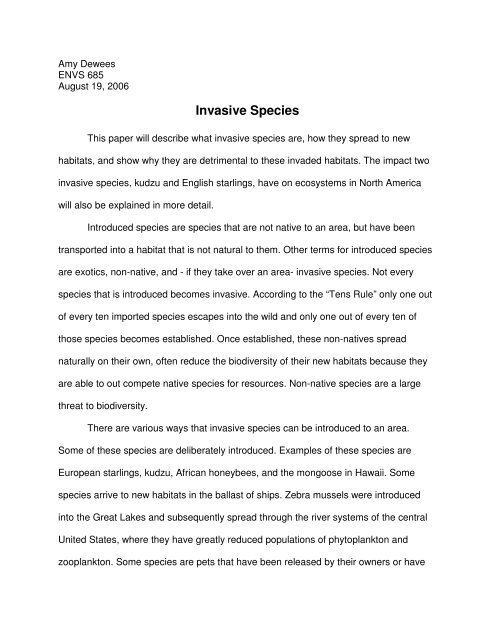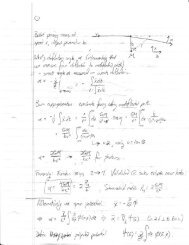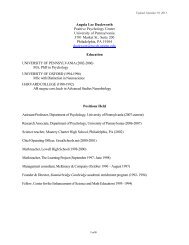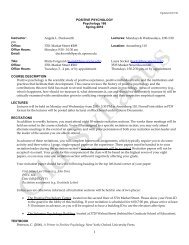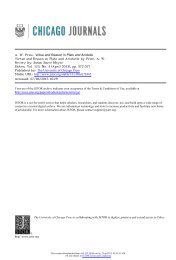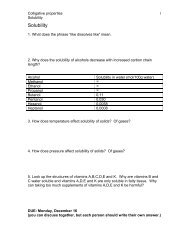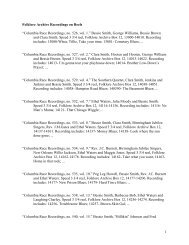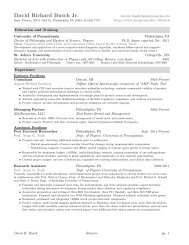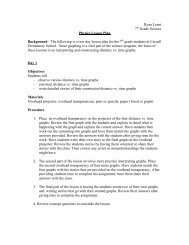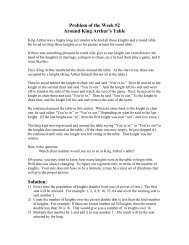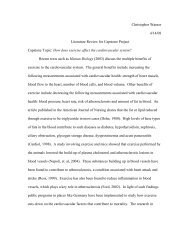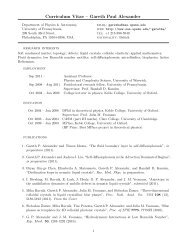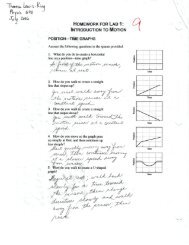Invasive Species Paper
Invasive Species Paper
Invasive Species Paper
Create successful ePaper yourself
Turn your PDF publications into a flip-book with our unique Google optimized e-Paper software.
Amy Dewees<br />
ENVS 685<br />
August 19, 2006<br />
<strong>Invasive</strong> <strong>Species</strong><br />
This paper will describe what invasive species are, how they spread to new<br />
habitats, and show why they are detrimental to these invaded habitats. The impact two<br />
invasive species, kudzu and English starlings, have on ecosystems in North America<br />
will also be explained in more detail.<br />
Introduced species are species that are not native to an area, but have been<br />
transported into a habitat that is not natural to them. Other terms for introduced species<br />
are exotics, non-native, and - if they take over an area- invasive species. Not every<br />
species that is introduced becomes invasive. According to the “Tens Rule” only one out<br />
of every ten imported species escapes into the wild and only one out of every ten of<br />
those species becomes established. Once established, these non-natives spread<br />
naturally on their own, often reduce the biodiversity of their new habitats because they<br />
are able to out compete native species for resources. Non-native species are a large<br />
threat to biodiversity.<br />
There are various ways that invasive species can be introduced to an area.<br />
Some of these species are deliberately introduced. Examples of these species are<br />
European starlings, kudzu, African honeybees, and the mongoose in Hawaii. Some<br />
species arrive to new habitats in the ballast of ships. Zebra mussels were introduced<br />
into the Great Lakes and subsequently spread through the river systems of the central<br />
United States, where they have greatly reduced populations of phytoplankton and<br />
zooplankton. Some species are pets that have been released by their owners or have
escaped from captivity. The gypsy moth escaped from a Boston laboratory and has<br />
devastated forests in Pennsylvania and New Jersey. The nutria was brought into North<br />
America from South America to be used in fur trade, but the efforts were unsuccessful<br />
and the nutria were released. Since their release in 1899, they have spread into 22<br />
states. Various species can be spread into new habitats by being carried with cargo.<br />
Norway rats, native to Asia, can now be found throughout the world.<br />
Loss of biodiversity is the largest ecological threat associated with introduced<br />
species. Introduced species can carry new diseases to which native species have no<br />
immunity. An example is the chestnut blight, a fungus that decimated the American<br />
chestnut. Chestnut blight is believed to have been carried by Chestnut trees imported<br />
from Asia. Introduced species may also prey upon native species, reducing their<br />
numbers. An example of this can be found on Guam, where the brown tree snake has<br />
devastated the native bird species which evolved without the influence of snakes and,<br />
as a result, had no defenses against snakes. Five of the eight native species have<br />
become extinct because of these (accidentally) introduced snakes. Introduced species<br />
may simply out-compete native species because the factors that control their<br />
populations in their native habitats, such as predators, parasites or other pathogens,<br />
climate conditions or geologic formations, are not present.<br />
Kudzu (Pueraria Montana) is sometimes called the “vine that ate the south,”<br />
“mile-a-minute vine,” and “foot-a-night vine.” It is a semi-woody, climbing, perennial vine<br />
that is in the pea family. It is a deciduous plant with broad leaves that can measure up<br />
to four inches across. It produces purple flowers and seeds in pods. It is indigenous to<br />
Southern and Eastern Asia. In its natural habitat, numerous natural enemies, including
species of insect and fungus, keep the population in check. Kudzu was introduced to<br />
the United States at the Philadelphia Centennial Exposition in 1876 and was promoted<br />
as an ornamental plant and forage crop. In 1935 the Soil Conservation Service began<br />
promoting its use to stop soil erosion along irrigation ditches, farmland, and railroad<br />
beds. In 1953, the United States Department of Agriculture recognized it as a pest weed<br />
because of its prolific spread. It can be found in much of the Southeastern United<br />
States, with severe infestations in Mississippi, Alabama, and Georgia, where it can grow<br />
almost anywhere over almost anything; along road banks, fields, forests, over buildings,<br />
roads, and telephone poles. Under the best conditions, it can grow as much as a foot a<br />
day. Its success in the United States can be attributed to various factors, including a<br />
lack of natural enemies. In its natural habitat in China, at least 25 species of insects<br />
have been found to feed on kudzu as well as six fungal pathogens that attack it. No<br />
such enemies are known to exist in the United States but studies are being conducted<br />
to determine if some of these insects or fungi from China could be introduced to help<br />
control the spread of kudzu in the United States. People in China also use it as a source<br />
of medicine and food. It produces large tubers, similar to potatoes that have various<br />
uses. Another reason for its success is its ability to reproduce. In the United States,<br />
kudzu produces seeds that are usually not viable because there are no insects that<br />
pollinate the flowers, but it is very effective at using vegetative means for reproduction.<br />
It puts out runners that root and grow. It produces large tubers that can survive repeated<br />
applications of herbicides and frost. Because of its quick growth, it can take over areas,<br />
killing off other vegetation because it blocks the light needed for photosynthesis and<br />
greatly reducing the biodiversity of the area.
The English starling (Sturnus vulgaris) is also known as the European starling<br />
and the common starling. It is about the size of a robin, but the tail is smaller. They are<br />
iridescent black with hints of green and purple. English starlings develop white spots on<br />
their plumage in the fall, which fades by during the winter. In March, their bills change<br />
from black to yellow (Stevens, 1997). The English starling is native to Europe, Asia, and<br />
North Africa, but has spread throughout the world, becoming established in New<br />
Zealand, Australia, South Africa and North America. The North American starling<br />
population originated from approximately 100 birds that were released in Central Park in<br />
the early 1890’s in an attempt to introduce all the birds mentioned in Shakespeare’s<br />
works to North America. The introduction of the starlings was very successful; the<br />
current population is estimated to be 150-200 million birds. One reason for the success<br />
of the English starlings is that they are habitat generalists: they are prolific in their<br />
natural habitat and tend to form large flocks that can number over 1,000. In their natural<br />
and introduced habitats, they are able to exploit a variety of food sources, including<br />
invertebrates, fruits, and seeds; they are successful in many different habitats including<br />
fields, marshes, agricultural fields, garbage dumps, sewage treatment plants, and cities.<br />
Because of their numbers, they can be extremely destructive and will compete with<br />
livestock for their feed and strip a field of any seeds that have been sown. They also<br />
destroy berry and fruit crops. Starlings are very aggressive and will drive birds (including<br />
native species) out of their nests so they can occupy the nesting site. Their nests of<br />
choice are in hollows of trees, such as those carved out by woodpeckers, but they will<br />
roost in buildings, in bird houses, under shingles, on cliff faces or in cracks in buildings.<br />
The aggressive nature of the starlings for nesting space has had a great impact on
many bird species that are native to North America, including the eastern bluebird, tree<br />
swallows, woodpeckers, and flickers.<br />
The introduction of non-native species into new habitats is a global concern.<br />
Introduced species are affecting native ecosystems, causing native species to become<br />
endangered or extinct. The disappearance of the native species may have severe<br />
consequences for other organisms that rely on them.
Works Cited<br />
Anderson, S., Beiswenger, R., & Purdom, P. (1993). Environmental science fourth edition. New York: Macmillan<br />
Publishing Company.<br />
Britton, Kerry (1999, September). International program news- the search for natural enemies for kudzu. Retrieved<br />
August 19, 2006, from USDA Forest Service Web site:<br />
http://www.fs.fed.us/global/news/oldnewsletters/september99/nlbody1099.htm<br />
Bryant, Peter J. (2004). Exotic <strong>Species</strong>. Retrieved August 20, 2006, from Biodiversity and Conservation Web site:<br />
http://darwin.bio.uci.edu/~sustain/bio65/lec14/b65lec14.htm#_EXOTIC_SPECIES<br />
Jones, Abb (1997, November 9). Stowaway snakes deplete bird population on Guam. Retrieved August 19, 2006,<br />
from CNNinteractive Web site: http://www.cnn.com/EARTH/9611/09/guam.snakes/index.html<br />
Stevens, Clarence (1997). European starling. Retrieved August 19, 2006, from Backyard Birds of Winter of Nova<br />
Scotia Web site: http://museum.gov.ns.ca/mnh/nature/winbirds/colour/c36.htm<br />
Van Driesche, R. (2002). Kudzu. Retrieved August 18, 2006, from <strong>Invasive</strong> and exotic species Web site:<br />
http://www.invasive.org/eastern/biocontrol/25Kudzu.html<br />
Westbrooks, Randy Forests. Retrieved August 11, 2006, from <strong>Invasive</strong> Plant Fact Bood Web site:<br />
https://www.denix.osd.mil/denix/Public/ES-Programs/Conservation/<strong>Invasive</strong>/forests.html#kudzu<br />
(2006, March 3). Introduced <strong>Species</strong>. Retrieved August 11, 2006, from U.S. Environmental Protection Agency Web<br />
site: http://www.epa.gov/maia/html/intro-species.html<br />
(2006, July 6). <strong>Invasive</strong> species: animals- european strarling. Retrieved August 19, 2006, from United States<br />
Department of Agriculture Web site: http://www.invasivespeciesinfo.gov/animals/eurostarling.shtml


